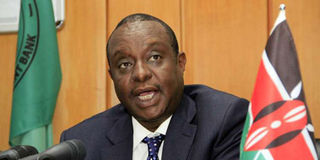Alarm as Kenya borrows Sh843m per day

National Treasury Cabinet Secretary Henry Rotich at a past function. Kenya borrowed a total of Sh178.78 billion between January and July, which translates to an average of Sh843 million a day for 212 days. PHOTO | FILE | NATION MEDIA GROUP
What you need to know:
- About Sh73 billion of the amount has already been disbursed, while agreements for the rest have been signed, which means the money can now be released.
- The largest single amount is Sh60.7 billion lent by the Chinese Government through the Beijing branch of the China Development Bank.
- All of the money, which is meant to finance infrastructure projects, has already been disbursed.
- In its analysis of the country’s economic circumstances ahead of the Budget this year, the PBO said the Treasury had failed to adhere to its own guidelines on debt management as external debt had been increasing by 27 per cent annually.
Kenya borrowed a total of Sh178.78 billion between January and July, which translates to an average of Sh843 million a day for 212 days, according to documents submitted to Parliament by the National Treasury last week.
The money was borrowed mostly to finance development projects. However, the Treasury’s explanation on the benefits of some of the projects is vague and calls for more scrutiny.
About Sh73 billion of the amount has already been disbursed, while agreements for the rest have been signed, which means the money can now be released.
The largest single amount is Sh60.7 billion lent by the Chinese Government through the Beijing branch of the China Development Bank.
All of the money, which is meant to finance infrastructure projects, has already been disbursed. The revelations are likely to provoke concerns about the rate at which Kenya’s foreign debt is piling up.
Suba MP John Mbadi of ODM said the Budget and Appropriations Committee needs to take its role seriously and scrutinise the debt and Treasury’s management strategy for borrowing in the short and long term.
“My fear is that the Jubilee government, particularly the Treasury, has no proper debt management strategy. This is something we have been complaining about,” said Mr Mbadi.
He said the Opposition’s fear is founded on the doubling of debt from Sh1.6 trillion in 2013 to Sh3.2 trillion now and on whether the money is going into areas that will contribute to the growth required for the cash to be paid back.
“Accounting for the Eurobond has been shrouded in confusion. If the government cannot account for productive assets, how can we be sure it went into productive areas? If there is no growth in the economy, the government that will take over from the current one will have to shoulder a very heavy burden,” said Mr Mbadi. He said the Parliamentary Budget Office (PBO) also needed to give its opinion on the Treasury’s handling of the debt.
ADHERE TO GUIDELINES
In its analysis of the country’s economic circumstances ahead of the Budget this year, the PBO said the Treasury had failed to adhere to its own guidelines on debt management as external debt had been increasing by 27 per cent annually.
“The total debt figure as at the end of June 2015 was notably higher than the projection in the Medium Term Debt Management Strategy, indicating lack of adherence to fiscal guidelines,” the team said.
The Treasury has had Parliament review the external debt limit twice since 2013 — from Sh800 billion to Sh1.2 trillion in January 2013, and then to Sh2.5 trillion in November 2014. This allowed the government to increase external debt by 86.3 per cent in the last four years, said the PBO.
Kitui Central MP Makali Mulu (Wiper) said the argument by the Treasury that international indicators show that Kenya is still in the safe zone as the debt-to-Gross Development Product ratio is below 70 per cent, is illusion.
“Because debt payment is the first charge on the Consolidated Fund, it drains our national revenue collection. It leads to a lack of flexibility in budget making since before you pay for anything else, you must pay the debt. It means we won’t have money to pay for development,” said Mr Mulu.
“We are not against borrowing, but we have reached a position where the country might find itself in a difficult situation,” he added.
In the latest submission, the International Development Association (IDA), a branch of the World Bank designed to help the world’s poorest countries, has signed deals that will see Kenya receive Sh51.44 billion.
Kenya is already at No. 5 on IDA’s ranking of top 10 borrowers in its 2015 financial year, receiving $1.5 billion (Sh151.9 billion) last year alone. Bangladesh was the year’s top borrower, having received $1.9 billion (Sh190 billion).
Of the money that the IDA has agreed to lend Kenya, the two largest amounts are Sh14.85 billion and Sh14.77 billion. They were agreed on July 4.
The Sh14.85 billion is earmarked for the Youth Employment and Opportunities Project, which is meant to “improve the social welfare of youth by providing quality and reliable jobs”. The other Sh14.77 billion is meant for the “Transforming Health System for Universal Care Project”.





